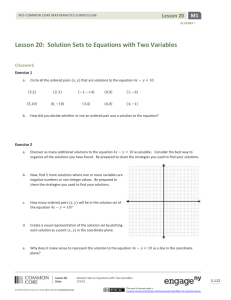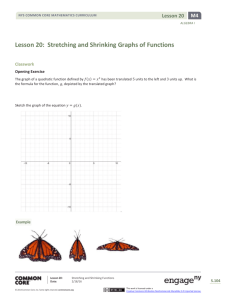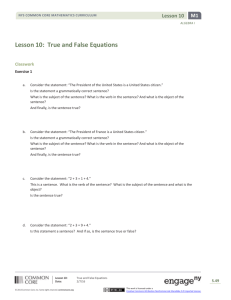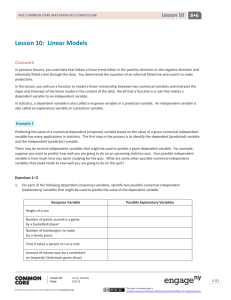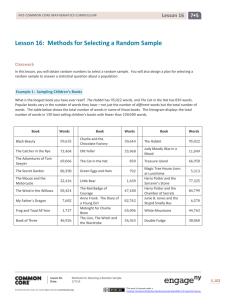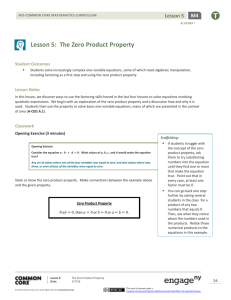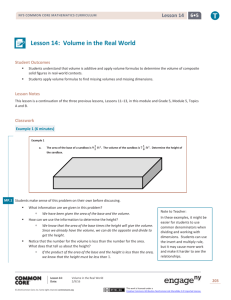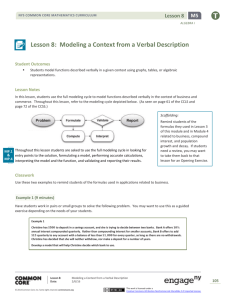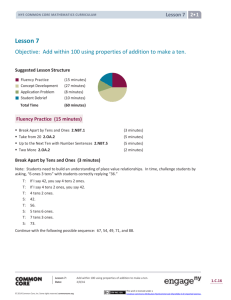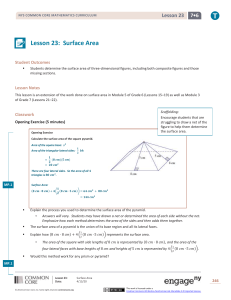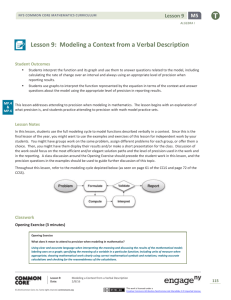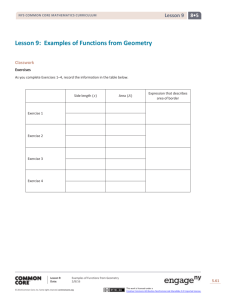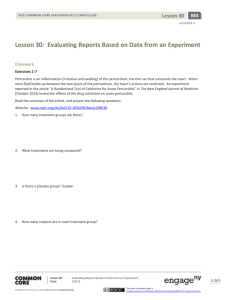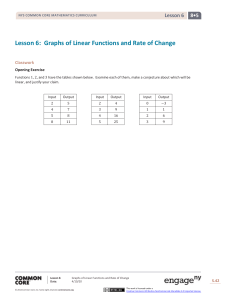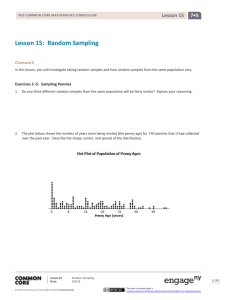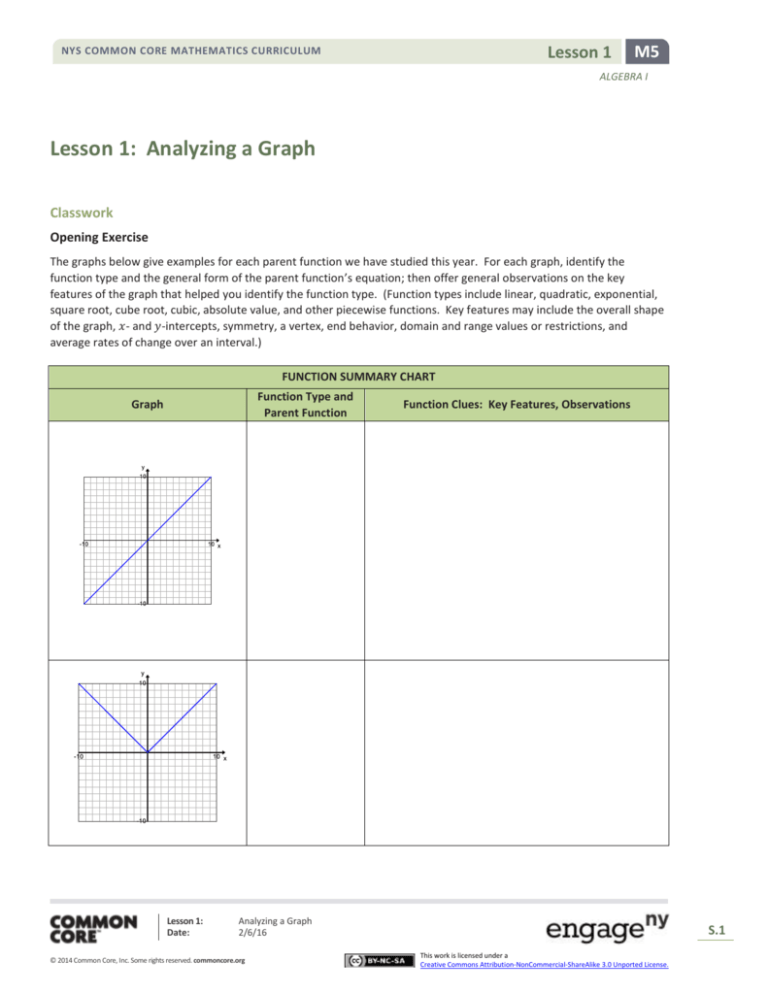
Lesson 1
NYS COMMON CORE MATHEMATICS CURRICULUM
M5
ALGEBRA I
Lesson 1: Analyzing a Graph
Classwork
Opening Exercise
The graphs below give examples for each parent function we have studied this year. For each graph, identify the
function type and the general form of the parent function’s equation; then offer general observations on the key
features of the graph that helped you identify the function type. (Function types include linear, quadratic, exponential,
square root, cube root, cubic, absolute value, and other piecewise functions. Key features may include the overall shape
of the graph, 𝑥- and 𝑦-intercepts, symmetry, a vertex, end behavior, domain and range values or restrictions, and
average rates of change over an interval.)
FUNCTION SUMMARY CHART
Function Type and
Parent Function
Graph
Lesson 1:
Date:
Function Clues: Key Features, Observations
Analyzing a Graph
2/6/16
© 2014 Common Core, Inc. Some rights reserved. commoncore.org
S.1
This work is licensed under a
Creative Commons Attribution-NonCommercial-ShareAlike 3.0 Unported License.
NYS COMMON CORE MATHEMATICS CURRICULUM
Lesson 1
M5
ALGEBRA I
Lesson 1:
Date:
Analyzing a Graph
2/6/16
© 2014 Common Core, Inc. Some rights reserved. commoncore.org
S.2
This work is licensed under a
Creative Commons Attribution-NonCommercial-ShareAlike 3.0 Unported License.
Lesson 1
NYS COMMON CORE MATHEMATICS CURRICULUM
M5
ALGEBRA I
Example 1
Earnings (dollars)
Eduardo has a summer job that pays him a certain rate for the first 40 hours each week and time-and-a-half for any
overtime hours. The graph below shows how much money he earns as a function of the hours he works in one week.
Time (hours)
Lesson 1:
Date:
Analyzing a Graph
2/6/16
© 2014 Common Core, Inc. Some rights reserved. commoncore.org
S.3
This work is licensed under a
Creative Commons Attribution-NonCommercial-ShareAlike 3.0 Unported License.
Lesson 1
NYS COMMON CORE MATHEMATICS CURRICULUM
M5
ALGEBRA I
Exercises
1.
Write the function in analytical (symbolic) form for the graph in Example 1.
a.
What is the equation for the first piece of the graph?
b.
What is the equation for the second piece of the graph?
c.
What are the domain restrictions for the context?
d.
Explain the domain in the context of the problem.
For each graph below use the questions and identified ordered pairs to help you formulate an equation to represent it.
2.
Function type:
Parent function:
Transformations:
Equation:
Lesson 1:
Date:
Analyzing a Graph
2/6/16
© 2014 Common Core, Inc. Some rights reserved. commoncore.org
S.4
This work is licensed under a
Creative Commons Attribution-NonCommercial-ShareAlike 3.0 Unported License.
Lesson 1
NYS COMMON CORE MATHEMATICS CURRICULUM
M5
ALGEBRA I
3.
Function type:
Parent function:
Transformations:
Equation:
4.
Function type:
Parent function:
Transformations:
Equation:
Lesson 1:
Date:
Analyzing a Graph
2/6/16
© 2014 Common Core, Inc. Some rights reserved. commoncore.org
S.5
This work is licensed under a
Creative Commons Attribution-NonCommercial-ShareAlike 3.0 Unported License.
Lesson 1
NYS COMMON CORE MATHEMATICS CURRICULUM
M5
ALGEBRA I
5.
Function type:
Parent function:
Transformations:
Equation:
6.
Function type:
Parent function:
Transformations:
Equation:
Lesson 1:
Date:
Analyzing a Graph
2/6/16
© 2014 Common Core, Inc. Some rights reserved. commoncore.org
S.6
This work is licensed under a
Creative Commons Attribution-NonCommercial-ShareAlike 3.0 Unported License.
M5
Lesson 1
NYS COMMON CORE MATHEMATICS CURRICULUM
ALGEBRA I
Lesson Summary
When given a context represented graphically, you must first:
Identify the variables in the problem (dependent and independent), and
Identify the relationship between the variables that are described in the graph or situation.
To come up with a modeling expression from a graph, you must recognize the type of function the graph
represents, observe key features of the graph (including restrictions on the domain), identify the
quantities and units involved, and create an equation to analyze the graphed function.
Identifying a parent function and thinking of the transformation of the parent function to the graph of the
function can help with creating the analytical representation of the function.
Problem Set
During tryouts for the track team, Bob is running 90-foot wind sprints by running from a starting line to the far wall
of the gym and back. At time 𝑡 = 0, he is at the starting line and ready to accelerate toward the opposite wall. As 𝑡
approaches 6 seconds, he must slow down, stop for just an instant to touch the wall, turn around, and sprint back to
the starting line. His distance, in feet, from the starting line with respect to the number of seconds that has passed
for one repetition is modeled by the graph below.
a.
What are the key features of this graph?
b.
What are the units involved?
c.
What is the parent function of this graph?
d.
Were any transformations made to the parent functions to get
this graph?
e.
What general analytical representation would you expect to
model this context?
f.
What do you already know about the parameters of the
equation?
g.
Use the ordered pairs you know to replace the parameters in the
general form of your equation with constants so that the equation
will model this context. Check your answer using the graph.
Distance from starting line (feet)
1.
(0, 0)
(12, 0)
Time (seconds)
Lesson 1:
Date:
Analyzing a Graph
2/6/16
© 2014 Common Core, Inc. Some rights reserved. commoncore.org
S.7
This work is licensed under a
Creative Commons Attribution-NonCommercial-ShareAlike 3.0 Unported License.
NYS COMMON CORE MATHEMATICS CURRICULUM
Lesson 1
M5
ALGEBRA I
2.
Spencer and McKenna are on a long-distance bicycle ride. Spencer leaves one hour before McKenna. The graph
below shows each rider’s distance in miles from his or her house as a function of time since McKenna left on her
bicycle to catch up with Spencer. (Note: Parts (e), (f), and (g) are challenge problems.)
a.
Which function represents Spencer’s distance? Which
function represents McKenna’s distance? Explain your
reasoning.
b.
Estimate when McKenna catches up to Spencer. How far
have they traveled at that point in time?
c.
One rider is speeding up as time passes and the other one is
slowing down. Which one is which, and how can you tell
from the graphs?
d.
According to the graphs, what type of function would best
model each rider’s distance?
e.
Create a function to model each rider’s distance as a
function of the time since McKenna started riding her
bicycle. Use the data points labeled on the graph to create a
precise model for each rider’s distance.
f.
What is the meaning of the 𝑥- and 𝑦-intercepts of each rider
in the context of this problem?
g.
Estimate which rider is traveling faster 30 minutes after
McKenna started riding. Show work to support your answer.
Lesson 1:
Date:
Analyzing a Graph
2/6/16
© 2014 Common Core, Inc. Some rights reserved. commoncore.org
S.8
This work is licensed under a
Creative Commons Attribution-NonCommercial-ShareAlike 3.0 Unported License.


